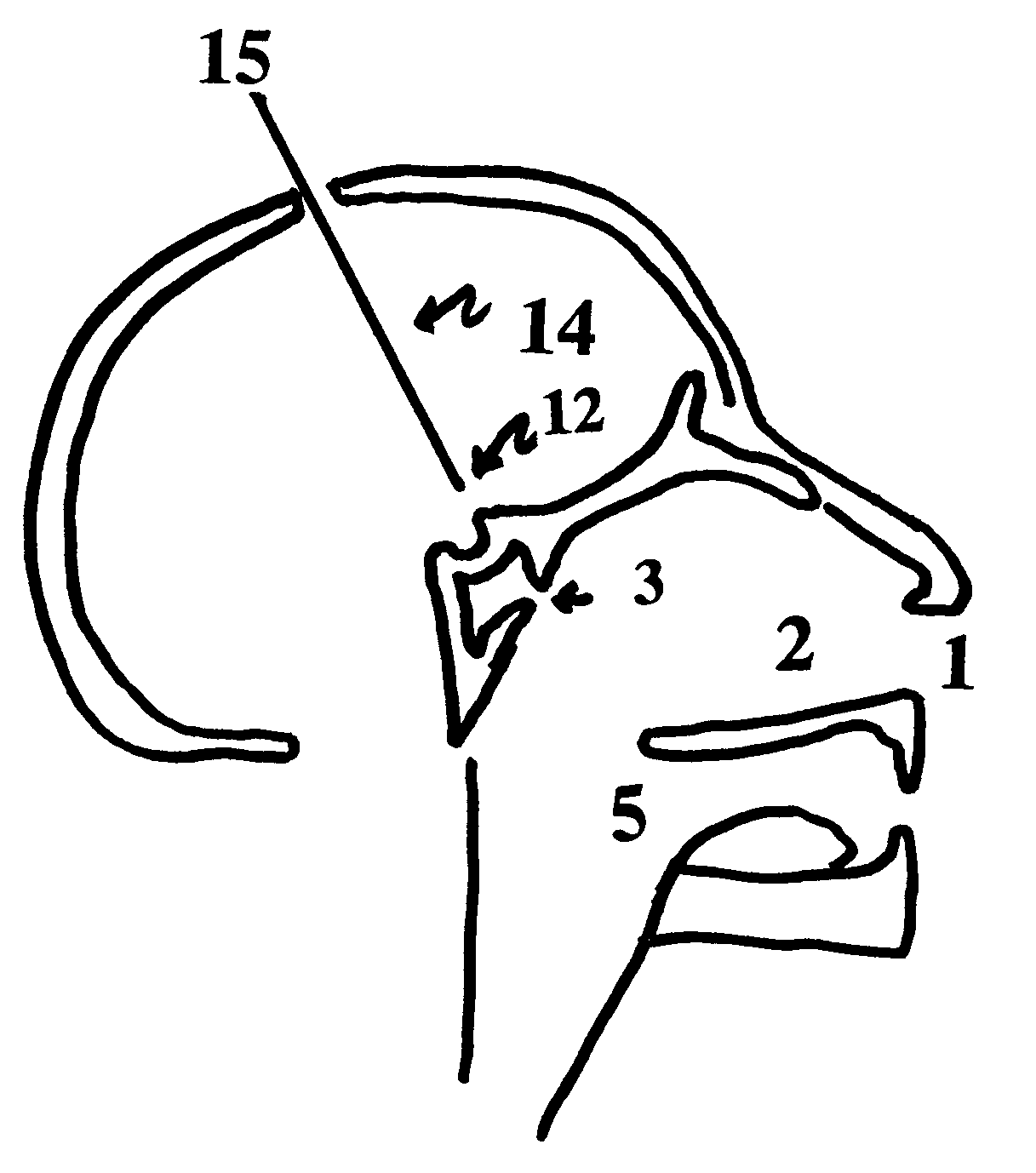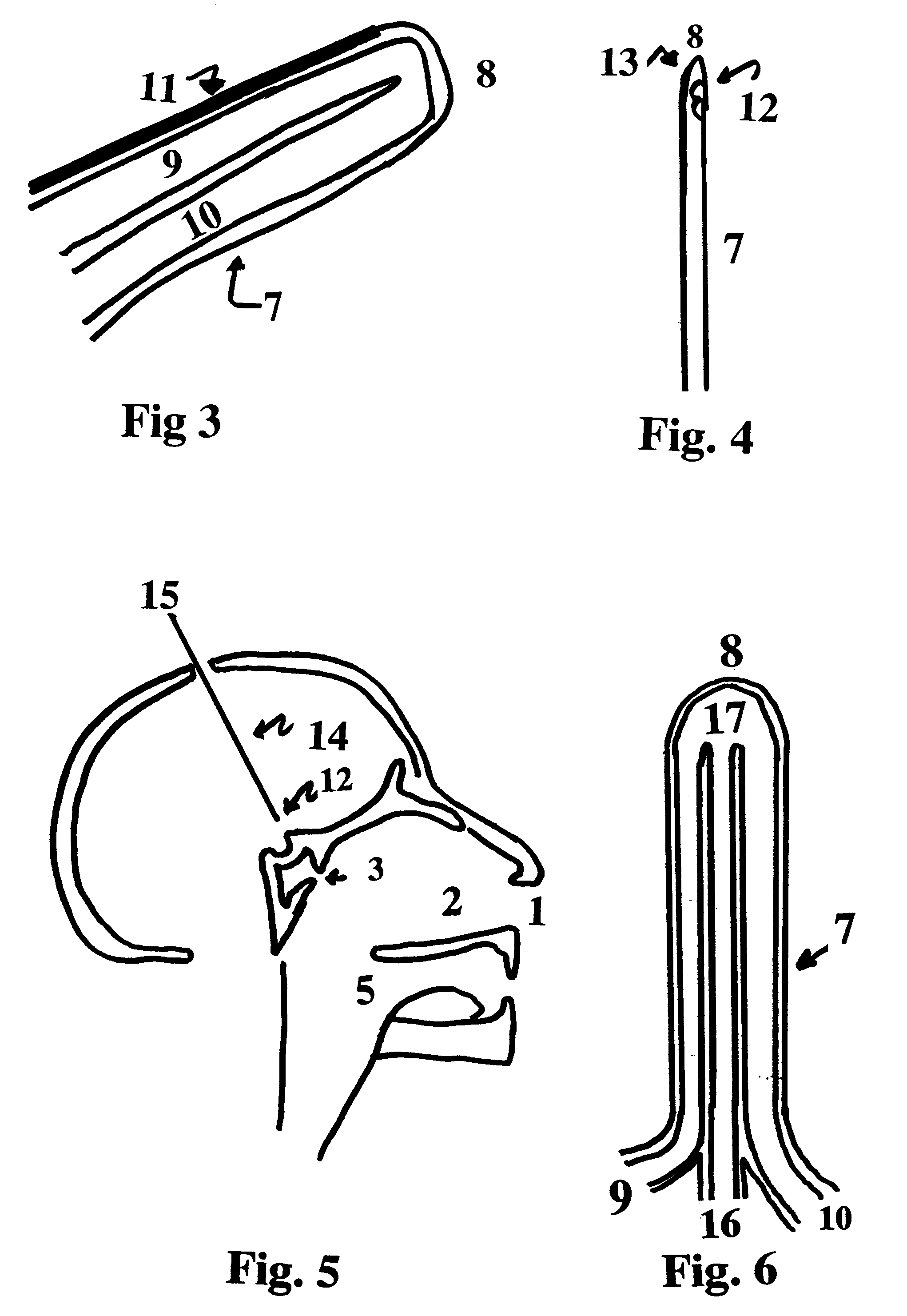Method for inducing hypothermia for treating neurological disorders
a neurological disorder and hypothermia technology, applied in the field of inducing hypothermia for treating neurological disorders, can solve the problems of many treatments and therapies, many attempts to reduce neurological damage, and most survive with some degree of neurological damage, and achieve the effect of raising body temperature and raising body temperatur
- Summary
- Abstract
- Description
- Claims
- Application Information
AI Technical Summary
Benefits of technology
Problems solved by technology
Method used
Image
Examples
example 2
This example illustrates the use of a warming tube inserted into the sphenoid sinus via a nostril. The warming tube is a flexible tube with two lumens. Warm saline (43.degree. C.) at a pressure head of 50 cm flows towards the distal end of the warming tube in one lumen, and returns via the other lumen at a pressure head of 0 cm. The distal end of the warming tube opens into and is enclosed by a distensible balloon made of latex rubber (wall thickness 0.005") which acts to direct the warm fluid flow from the inflow tube to the outflow tube. A stainless steel guide wire 11 cm in length with a shapeable tip, gently curved for the last 4 mm, is inserted into the guidewire lumen and is used to direct the distal end of the warming tube into the sphenoid sinus. The latex rubber balloon at the distal end of the warming tube expands into the sphenoid sinus once the outflow pressure head becomes positive following partial occlusion of the outflow. The circulation of warm saline inside the bal...
example 3
This example illustrates the use of warm gas to warm a nasal passage, sinus and hypothalamus and the additional use of compounds effective to increase the hypothermia induced by warming a nasal passage, sinus and hypothalamus. A mixture of 25% steam and 75% air (v / v) with added melatonin and capsaicin is combined in a chamber to which is connected a two-lumen flexible polyethylene extrusion of outer diameter 4 mm which is inserted into the nostrils of a human subject. The melatonin and capsaisin are added to the mixing chamber via an atomizer spray as a solution in saline (0.9% sodium chloride) of 10 nM melatonin, 1 mg / mL bovine serum albumin and 100 nM capsaicin. The human subject breathes the warm gas mixture normally through the nose. In approximately 5 minutes, the animal begins to sweat. This physiological cooling response is effective to lower the animal's body temperature.
example 4
This example illustrates the use of direct heating in the hypothalamus to produce a physiological cooling response. Standard imaging techniques are used to image the brain of the human patient prior to any surgical procedures. Accepted neurosurgical procedures are followed when exposing the skull and drilling a small hole in the skull 15, inserting a guide-tube under stereotactic control. After local anesthetic is applied, a Leksell stereotactic frame is applied to the head of a human patient and an incision in the scalp is made, exposing the skull. A single 3-mm twist drill hole is made in the exposed skull anterior to the coronal suture approximately 2 cm from the midline. The dura is penetrated with a sharp probe and a 1.1 mm guide tube is stereotactically placed in the cerebrum so that the tip is within 1 cm of the anterior hypothalamus. A sterile microelectrode is attached to a hydraulic microdrive and the tip of the electrode is advanced down the guide tube until it protrudes ...
PUM
 Login to View More
Login to View More Abstract
Description
Claims
Application Information
 Login to View More
Login to View More - R&D
- Intellectual Property
- Life Sciences
- Materials
- Tech Scout
- Unparalleled Data Quality
- Higher Quality Content
- 60% Fewer Hallucinations
Browse by: Latest US Patents, China's latest patents, Technical Efficacy Thesaurus, Application Domain, Technology Topic, Popular Technical Reports.
© 2025 PatSnap. All rights reserved.Legal|Privacy policy|Modern Slavery Act Transparency Statement|Sitemap|About US| Contact US: help@patsnap.com



